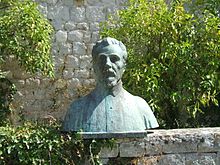Hanibal Lucic
Hanibal Lucić (* around 1485 in Hvar ; † December 14, 1553 in Venice ) was a Croatian writer of the Renaissance .
life and work
The son of wealthy and influential parents worked as a judge and lawyer and spent most of his life on his home island of Hvar . Much of his works (especially the early ones) have not survived because he rejected and destroyed them.
The best known and most widely received work by Lucić is Robinja (The Slave Girl), the very first secular drama in Croatian literature. It was published, together with verses by Lucić, in Venice in 1556, i.e. only after his death, but saw numerous editions in the following centuries. At the center of this rather “actionless” and in parts “rambling” love drama are the aristocrat Derenčin and a beautiful woman who was stolen by the Turks in Budapest and whom he meets at the slave market in Dubrovnik . In the end, she becomes his bride. In his songs, too, Lucić mainly revolved around the subject of love. In all of Lucić's works, Italian influences ( Francesco Petrarca , Pietro Bembo ) combined with his passion for the everyday language of Croatian farmers and shepherds. It did not prevent him from calling his compatriots, who rebelled against the Venetian rulers of Hvar between 1510 and 1514, a “bunch of fools”.
In the town of Hvar, on the square in front of the Benedictine monastery, there is a sculpture made of white sandstone in honor of the poet. He is shown in a kneeling position with a book on a lectern. In the former residential complex of Lucić, the monastery was opened in 1660 and in the 19th century the Agave Lace Museum was opened there. The museum is called Muzej Hanibal Lucić .
literature
- Branko Vodnik: Postajanje Lucić "Robinje" , in: Rad JAZU 176, 1909
- Mihovil Kombol: Hanibal Lucić , in: Literatura 1, 1957
- Marin Franičević: Uz stihove Hanibal Lucić , in: Ders .: Knjizevnost jucer i danas , Zagreb 1959, pages 81-95
- Marin Franičević: Nad kanconijerom Hanibal Lucić , in: Izraz 3, 1959, pages 94-104
- Cvito Fisković: Bastina starih hrvatskih pisaca , 2 volumes, Split 1971
- Franjo Švelec: "Robinja" Hanibal Lucić , in: Mogucnosti 20, 1973, pages 668-681
- Dani hvarskog kazalista , Hvar 1975
- Josip Vonćina: O izvorima i jezicnim slojevima Lucić “Robinje” , in: Ders .: Analize starih hrvatskih pisaca , Split 1977, pages 91–129
- Nikica Columbić: Hanibal Lucić , in: Hrvatska knjizevnost od humanizma do manirizma . Zagreb 1980, pages 211-217
- Nikola Batušić: Dani hvarskog kazališta: Hanibal Lucić , Split 1987
- Joanna Rapacka: Leksikon hrvatskih tradicija , Zagreb 2002
Individual evidence
- ↑ a b Kindler's New Literature Lexicon , Munich 1988 edition
- ^ Ante Kadić: Croatian Renaissance . In: Studies in the Renaissance . tape 6 , 1959, pp. 28-35, p. 34 , JSTOR : 2857180 .
- ↑ According to the English Wikipedia , accessed on January 10, 2012, see also Hvar Rebellion
Web links
| personal data | |
|---|---|
| SURNAME | Lucić, Hanibal |
| BRIEF DESCRIPTION | Croatian poet and writer of the Renaissance |
| DATE OF BIRTH | around 1485 |
| PLACE OF BIRTH | Hvar |
| DATE OF DEATH | December 14, 1553 |
| Place of death | Venice |
